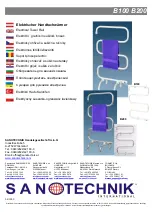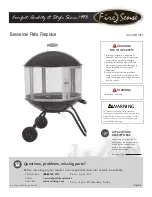
24
Table K: Venting Category Requirements
Vent Terminal Location
1. Condensate can freeze on the vent cap. Frozen
condensate on the vent cap can result in a blocked
flue condition.
2. Give special attention to the location of the vent
termination to avoid possibility of property dam-
age or personal injury.
3. Gases may form a white vapor plume in winter.
The plume could obstruct a window view if the ter-
mination is installed near windows.
4. Prevailing winds, in combination with below-freez-
ing temperatures, can cause freezing of
condensate and water/ice build-up on buildings,
plants or roofs.
5. The bottom of the vent terminal and the air intake
shall be located at least 12 in. above grade, includ-
ing normal snow line.
6. Single-wall Category IV metal vent pipe shall not
be used outdoors in cold climates for venting gas-
fired equipment without insulation.
7. Through-the-wall vents for Category IV appli-
ances shall not terminate over public walkways or
over an area where condensate or vapor could
create a nuisance or hazard or could be detrimen-
tal to the operation of regulators, relief valves, or
other equipment.
8. Locate and guard vent termination to prevent acci-
dental contact by people or pets.
9. DO NOT terminate vent in window well, stairwell,
alcove, courtyard or other recessed area.
10. DO NOT terminate above any door, window, or
gravity air intake. Condensate can freeze, causing
ice formations.
NOTE:
During winter months check the vent cap
and make sure no blockage occurs from build-up of
snow or ice.
Use only approved PVC or CPVC vent materials (in
Canada, ULC-S636 approved plastic materials must
be used) or special gas vent pipes listed for use with
Category IV gas burning heaters, such as the AL29-4C
stainless steel vents offered by Heat Fab Inc. (800-
772-0739), Protech System, Inc. (800-766-3473),
Z-Flex (800-654-5600) or American Metal Products
(800-423-4270). Pipe joints must be positively sealed.
Follow the vent manufacturer’s installation instructions
carefully. Vent installations shall be in accordance with
Part 7, Venting of Equipment, of the NFGC, ANSI
Z223.1/NFPA 54, Section 7, Venting Systems and Air
Supply for Appliances, of the B149 Code, or applicable
provisions of the local building codes.
Support of Vent Stack
The weight of the vent stack or chimney must not rest
on the heater vent connection. Support must be pro-
vided in compliance with applicable codes. The vent
should also be installed to maintain proper clearances
from combustible materials. Use insulated vent pipe
spacers where the vent passes through combustible
roofs and walls.
When using PVC or CPVC venting on models 300,
400 and 500, insert the vent pipe 3-5 inches into the
unit and provide rigid support to the vent, so that it will
not shift laterally.
WARNING:
Do not use foam core or cellular core
pipe for venting.
Combustion
Air Supply
Exhaust
Configuration
Heater Venting
Category
Certified Vent
Materials
Combustion Air
Inlet Material
From Inside Building
(Non-Direct Venting)
Vertical Venting
IV
(Canada Only: ULC-
S636 PVC and CPVC)
Stainless Steel,
AL29-4C, ANSI/ASTM
D1785 Sch 40 PVC,
ANSI/ASTM F441 Sch
40 CPVC
Horizontal Through-
the-Wall Venting
From Outside Building
(Direct Venting)
Vertical Venting
Galvanized Steel,
PVC, ABS,
CPVC
Horizontal Through-
the-Wall Venting
WARNING:
DO NOT insulate PVC or CPVC vent
pipe.
Summary of Contents for H 300 Series
Page 40: ...40 WIRING DIAGRAM...
















































